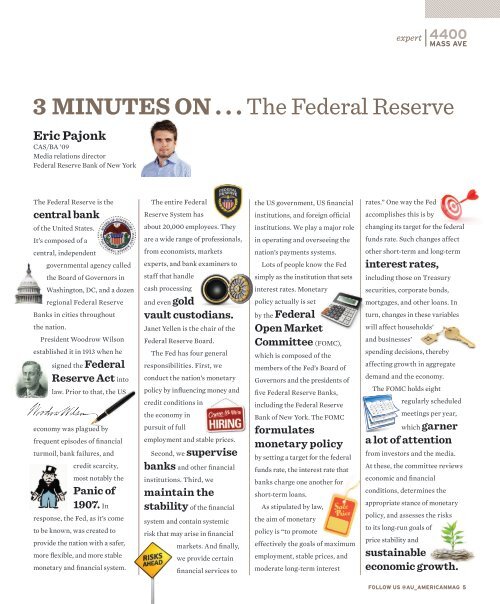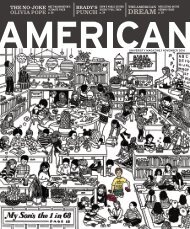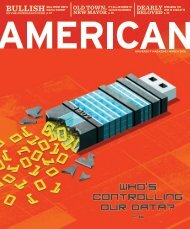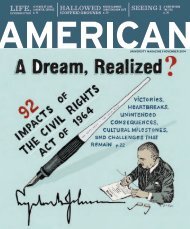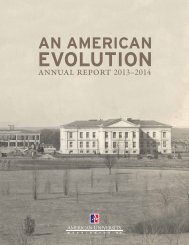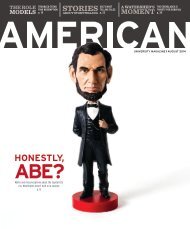American Magazine: November 2015
In this issue, explore the painful past and peaceful rebirth of Hiroshima; meet plane crash survivor and author Robin Suerig Holleran; reminisce about a time when AU was a soccer powerhouse, hop on the Metro to Bethesda, and get to know some of AU’s 1,800 San Fran transplants. Also in the November issue: 3 minutes on the Federal Reserve, the history of Clawed, and an Uber quiz.
In this issue, explore the painful past and peaceful rebirth of Hiroshima; meet plane crash survivor and author Robin Suerig Holleran; reminisce about a time when AU was a soccer powerhouse, hop on the Metro to Bethesda, and get to know some of AU’s 1,800 San Fran transplants. Also in the November issue: 3 minutes on the Federal Reserve, the history of Clawed, and an Uber quiz.
Create successful ePaper yourself
Turn your PDF publications into a flip-book with our unique Google optimized e-Paper software.
expert<br />
3 MINUTES ON . . . The Federal Reserve<br />
Eric Pajonk<br />
CAS/BA ’09<br />
Media relations director<br />
Federal Reserve Bank of New York<br />
The Federal Reserve is the<br />
central bank<br />
of the United States.<br />
It’s composed of a<br />
central, independent<br />
governmental agency called<br />
the Board of Governors in<br />
Washington, DC, and a dozen<br />
regional Federal Reserve<br />
Banks in cities throughout<br />
the nation.<br />
President Woodrow Wilson<br />
established it in 1913 when he<br />
signed the Federal<br />
Reserve Act into<br />
law. Prior to that, the US<br />
economy was plagued by<br />
frequent episodes of financial<br />
turmoil, bank failures, and<br />
credit scarcity,<br />
most notably the<br />
Panic of<br />
1907. In<br />
response, the Fed, as it’s come<br />
to be known, was created to<br />
provide the nation with a safer,<br />
more flexible, and more stable<br />
monetary and financial system.<br />
The entire Federal<br />
Reserve System has<br />
about 20,000 employees. They<br />
are a wide range of professionals,<br />
from economists, markets<br />
experts, and bank examiners to<br />
staff that handle<br />
cash processing<br />
and even gold<br />
vault custodians.<br />
Janet Yellen is the chair of the<br />
Federal Reserve Board.<br />
The Fed has four general<br />
responsibilities. First, we<br />
conduct the nation’s monetary<br />
policy by influencing money and<br />
credit conditions in<br />
the economy in<br />
pursuit of full<br />
employment and stable prices.<br />
Second, we supervise<br />
banks and other financial<br />
institutions. Third, we<br />
maintain the<br />
stability of the financial<br />
system and contain systemic<br />
risk that may arise in financial<br />
markets. And finally,<br />
we provide certain<br />
financial services to<br />
the US government, US financial<br />
institutions, and foreign official<br />
institutions. We play a major role<br />
in operating and overseeing the<br />
nation’s payments systems.<br />
Lots of people know the Fed<br />
simply as the institution that sets<br />
interest rates. Monetary<br />
policy actually is set<br />
by the Federal<br />
Open Market<br />
Committee (FOMC),<br />
which is composed of the<br />
members of the Fed’s Board of<br />
Governors and the presidents of<br />
five Federal Reserve Banks,<br />
including the Federal Reserve<br />
Bank of New York. The FOMC<br />
formulates<br />
monetary policy<br />
by setting a target for the federal<br />
funds rate, the interest rate that<br />
banks charge one another for<br />
short-term loans.<br />
As stipulated by law,<br />
the aim of monetary<br />
policy is “to promote<br />
effectively the goals of maximum<br />
employment, stable prices, and<br />
moderate long-term interest<br />
rates.” One way the Fed<br />
accomplishes this is by<br />
changing its target for the federal<br />
funds rate. Such changes affect<br />
other short-term and long-term<br />
interest rates,<br />
including those on Treasury<br />
securities, corporate bonds,<br />
mortgages, and other loans. In<br />
turn, changes in these variables<br />
will affect households’<br />
and businesses’<br />
spending decisions, thereby<br />
affecting growth in aggregate<br />
demand and the economy.<br />
The FOMC holds eight<br />
regularly scheduled<br />
meetings per year,<br />
which garner<br />
a lot of attention<br />
from investors and the media.<br />
At these, the committee reviews<br />
economic and financial<br />
conditions, determines the<br />
appropriate stance of monetary<br />
policy, and assesses the risks<br />
to its long-run goals of<br />
price stability and<br />
sustainable<br />
economic growth.<br />
FOLLOW US @AU_AMERICANMAG 5


